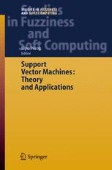Search
Search Results
-
Adaptive Discriminant and Quasiconformal Kernel Nearest Neighbor Classification
Nearest neighbor classification assumes locally constant class conditional probabilities. This assumption becomes invalid in high dimensions due to...
-
Clustering with Intelligent Techniques
Cluster analysis is a technique for grou** data and finding structures in data. The most common application of clustering methods is to partition a...
-
Active-Set Methods for Support Vector Machines
This chapter describes an active-set algorithm for quadratic programming problems that arise from the computation of support vector machines (SVMs)....
-
Local Learning vs. Global Learning: An Introduction to Maxi-Min Margin Machine
We present a unifying theory of the Maxi-Min Margin Machine (M4) that subsumes the Support Vector Machine (SVM), the Minimax Probability Machine...
-
Application of Support Vector Machine to the Detection of Delayed Gastric Emptying from Electrogastrograms
The radioscintigraphy is currently the gold standard for gastric emptying test, but it involves radiation exposure and considerable expenses. Recent...
-
Unsupervised Learning Neural Networks
This chapter introduces the basic concepts and notation of unsupervised learning neural networks. Unsupervised networks are useful for analyzing data...
-
Evolutionary Computing for Architecture Optimization
This chapter introduces the basic concepts and notation of evolutionary algorithms, which are basic search methodologies that can be used for...
-
Introduction to Pattern Recognition with Intelligent Systems
We describe in this book, new methods for intelligent pattern recognition using soft computing techniques. Soft Computing (SC) consists of several...
-
Supervised Learning Neural Networks
In this chapter, we describe the basic concepts, notation, and basic learning algorithms for supervised neural networks that will be of great use for...
-
Face Recognition with Modular Neural Networks and Fuzzy Measures
We describe in this chapter a new approach for face recognition using modular neural networks with a fuzzy logic method for response integration. We...
-
Intuitionistic and Type-2 Fuzzy Logic
We describe in this chapter two new areas in fuzzy logic, type-2 fuzzy logic systems and intuitionistic fuzzy logic. Basically, a type-2 fuzzy set is...
-
An Accelerated Robust Support Vector Machine Algorithm
This chapter proposes an accelerated decomposition algorithm for robust support vector machine (SVM). Robust SVM aims at solving the overfitting...
-
Real-time water surface target detection based on improved YOLOv7 for Chengdu Sand River
It has been a challenge to obtain accurate detection results in a timely manner when faced with complex and changing surface target detection....

-
Exploring methods for the generation of visual counterfactuals in the latent space
In the field of eXplainable Artificial Intelligence (XAI), the generation of counterfactuals is a promising method for human-interpretable...

-
EdgeNet: a low-power image recognition model based on small sample information
Existing deep convolutional neural networks that rely on large datasets typically require images with high resolution and deep neural network models...

-
Boosting person ReID feature extraction via dynamic convolution
Extraction of discriminative features is crucial in person re-identification (ReID) which aims to match a query image of a person to her/his images,...

-
Exploration and Exploitation of Unlabeled Data for Open-Set Semi-supervised Learning
In this paper, we address a complex but practical scenario in semi-supervised learning (SSL) named open-set SSL, where unlabeled data contain both...

-
DTS: dynamic training slimming with feature sparsity for efficient convolutional neural network
Deep convolutional neural networks have achieved remarkable progress on computer vision tasks over last years. In this paper, we proposed a dynamic...

-
Infproto-Powered Adaptive Classifier and Agnostic Feature Learning for Single Domain Generalization in Medical Images
Designing a single domain generalization (DG) framework that generalizes from one source domain to arbitrary unseen domains is practical yet...

-
IAFPN: interlayer enhancement and multilayer fusion network for object detection
Feature pyramid network (FPN) improves object detection performance by means of top-down multilevel feature fusion. However, the current FPN-based...

